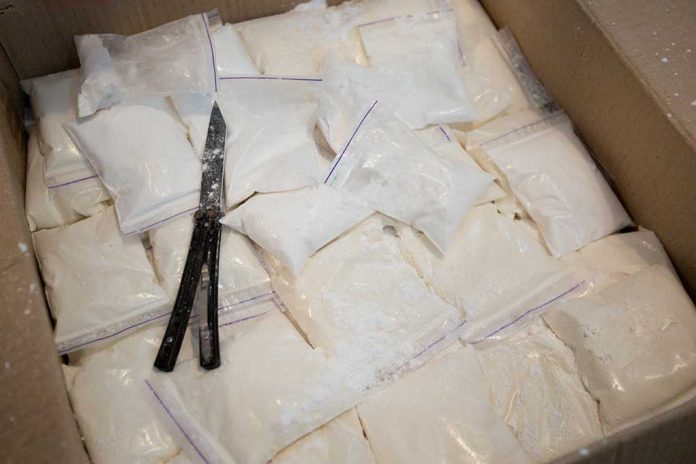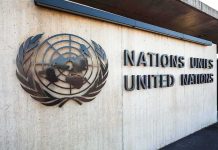
A high-ranking Guyana police officer and five other individuals have been sanctioned by the US Treasury Department for operating a massive cocaine trafficking network that utilized “narco submarines,” illegal airstrips, and corrupt official channels to smuggle drugs internationally.
Key Takeaways
- Senior Superintendent Himnauth Sawh, a current Guyana police officer, along with five others from Guyana and Colombia have been sanctioned by the US for sophisticated cocaine trafficking operations.
- The network employed “narco submarines,” hidden airstrips, and underground bunkers to transport cocaine from South America to the US, Europe, and the Caribbean.
- Paul Daby Jr. and Randolph Duncan allegedly operate Guyana’s largest drug trafficking operation, with Duncan extending routes to Africa and Daby also trafficking illegal gold.
- The sanctions block all US-based property and interests of these individuals, reflecting President Trump’s continued commitment to fighting international drug trafficking.
- Corruption at Guyana’s ports and borders has facilitated the movement of narcotics, with a recent seizure of 4.4 tonnes of cocaine valued at over G$40.7 billion found near an illegal airstrip.
Police Corruption Facilitates Massive Drug Operation
In a significant enforcement action targeting international narcotics trafficking, the US Treasury Department has sanctioned six individuals from Guyana and Colombia for their roles in sophisticated cocaine smuggling operations. Among those sanctioned is Senior Superintendent Himnauth Sawh, 37, a current Guyana police officer and former Commander of Region One (Barima-Waini), who is accused of providing protection to Mexican and Venezuelan drug traffickers. The sanctions highlight the infiltration of corruption into law enforcement, creating protected pathways for narcotics moving from South America to North America and Europe.
“The former Region One Police Commander Himnauth Sawh, 37, was today named in a statement from the US Department of Treasury Office of Foreign Assets Control (OFAC) in relation to the transshipping of cocaine from Guyana to the US,” stated US Department of Treasury Office of Foreign Assets Control (OFAC).
The timing of these sanctions is particularly noteworthy, as they follow the September discovery of 4.4 tonnes of cocaine valued at over G$40.7 billion near an illegal airstrip at Matthew’s Ridge during Sawh’s tenure as regional commander. After this massive seizure, Sawh was quietly reassigned to head the Transport Workshop without any public explanation from the police force. Three other Guyanese nationals sanctioned include Paul Daby Jr., Mark Cromwell (another former police officer), and Randolph Duncan, demonstrating the extensive network of corrupt officials enabling this criminal enterprise.
Today, the U.S. Department of the Treasury’s Office of Foreign Assets Control sanctioned four Guyanese nationals and two Colombian nationals responsible for trafficking tons of cocaine from South America to the United States, Europe, and the Caribbean.
Today’s sanctions target…
— Treasury Department (@USTreasury) June 5, 2025
Sophisticated Smuggling Methods Evade Detection
The trafficking network employs highly sophisticated methods to evade international law enforcement. According to US Treasury officials, Paul Daby Jr. and Randolph Duncan operate what is believed to be the largest drug trafficking operation in Guyana, utilizing semi-submersible “narco submarines” capable of transporting up to 3 tons of cocaine per journey. These vessels are increasingly being used to cross the Atlantic to Western Europe, showing the global reach of these criminal networks. Alongside narco subs, the operation employs small aircraft landing on remote airstrips to import cocaine from Colombia and Venezuela.
“Drug traffickers exploit the rivers and jungles of South America by transiting large quantities of cocaine, from Colombia and Venezuela, through the waters of Guyana and Suriname,” stated US Department of Treasury Office of Foreign Assets Control (OFAC).
The operation’s sophistication extends to its storage methods. Once in Guyana, cocaine shipments are often buried in underground bunkers on airstrips and in jungle areas, particularly in the Barima-Waini region, where they await redistribution. Duncan, according to Treasury officials, manages cocaine trafficking routes from Guyana to Africa, the Caribbean, Europe, and the United States, while Daby Jr. has expanded his criminal enterprise to include trafficking illegal gold. This diversification of both routes and commodities makes the network particularly resilient to enforcement efforts.
NEW!! US sanctions 4 Guyanese and 2 Colombian nationals responsible for trafficking tons of cocaine from South America to the U.S, Europe, and the Caribbean, per @USTreasury pic.twitter.com/CennNJMMs2
— Alex Raufoglu (@ralakbar) June 5, 2025
International Response and Continuing Challenges
The US sanctions represent a significant financial blow to the trafficking network. Treasury officials made clear that the sanctions will block all property and interests of these individuals within US jurisdiction. This is the second instance in the past year where the US Office of Foreign Assets Control has sanctioned Guyanese individuals, reflecting President Trump’s ongoing commitment to disrupting international drug trafficking operations that threaten American communities.
“As a result of today’s action, all property and interests in property of the designated or blocked persons described above that are in the United States or in the possession or control of U.S. persons are blocked and must be reported to OFAC,” stated the Treasury Department.
Despite these efforts, the challenges of combating narcotics trafficking through Guyana remain substantial. The country’s extensive rivers, dense jungles, and porous borders create ideal conditions for drug smuggling. In the previous year alone, authorities discovered over 8,000 pounds of cocaine near the Venezuela border. In March 2025, officials intercepted 182 kilograms of cocaine on a cargo vessel off Trinidad and Tobago. These seizures, while significant, likely represent only a fraction of the total volume moving through established trafficking corridors that exploit Guyana’s geography and corrupt officials.









